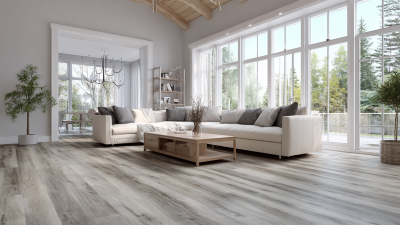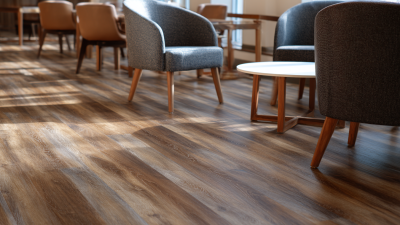When it comes to selecting flooring that combines durability, aesthetics, and affordability, SPC plank flooring has emerged as a top choice among homeowners and designers alike. According to a recent report by Market Research Future, the global SPC flooring market is projected to grow at a CAGR of 7.5% from 2021 to 2026, driven by its resilience against moisture and scratches, making it ideal for high-traffic areas. With various styles and finishes available, it can replicate the look of natural wood or stone while offering practical advantages. However, choosing the right SPC plank flooring can be daunting due to the myriad of options on the market. In this blog, we will explore seven essential tips that will help you make an informed decision, ensuring that your investment enhances both the functionality and beauty of your space.

When selecting SPC (Stone Plastic Composite) plank flooring, it’s crucial to understand the various types available on the market today. SPC flooring is known for its durability and water resistance, offering a practical solution for both residential and commercial spaces. Among the options, you can find products with different thicknesses, textures, and finishes, each suited to specific needs and aesthetic preferences. Generally, thicker planks provide better sound insulation and durability, while a variety of textures can mimic natural wood or stone, adding character to any room.
Additionally, the construction of SPC planks can vary, with some featuring enhanced protective layers that resist scratches and stains. This is especially important in high-traffic areas where wear and tear is a concern. When choosing SPC planks, consider options with a good warranty that reflect their quality and longevity. Look for environmentally friendly options as well, as many manufacturers now offer sustainable products that do not compromise on performance. Understanding these distinctions will empower you to make an informed choice that aligns with your lifestyle and design goals.
When it comes to installing SPC (Stone Plastic Composite) plank flooring, accurate measurements of your space are critical to ensuring a perfect fit. Start by measuring the length and width of the room where you'll be laying the flooring. It's advisable to measure in multiple locations, especially in irregularly shaped rooms, as walls may not always be perfectly straight. Be sure to record your measurements in both inches and centimeters for compatibility with the flooring specifications you select.
Another key factor to consider is accounting for the layout and design of your flooring. Determine whether you will be installing the planks parallel or perpendicular to the longest wall in the room, as this can affect the amount of material needed and the overall aesthetic. Additionally, factor in any doorways, alcoves, or fixtures that may require special cuts or adjustments. A well-planned measurement strategy not only saves time and materials but also helps you achieve a seamless and professional-looking installation.

When selecting SPC plank flooring, durability and wear ratings should be at the forefront of your decision-making process. SPC, or Stone Plastic Composite, is known for its resilience, making it a popular choice for high-traffic areas. To evaluate its durability, look for products that offer a high wear layer thickness—typically between 12 to 30 mils. A thicker wear layer not only enhances scratch and dent resistance but also contributes to the longevity of the flooring in demanding environments.
Additionally, the wear rating, often measured by the ASTM or Mohs scale, provides insight into how well the flooring can withstand everyday use. A rating of AC3 or higher is generally recommended for residential areas, while commercial settings may benefit from AC4 or AC5 ratings. Always check for manufacturer guarantees as they can provide further assurance regarding the product's performance. By prioritizing these aspects, you can confidently choose SPC plank flooring that aligns with your needs and lifestyle, ensuring it will endure the test of time.
| Tip | Description | Durability Rating | Wear Layer Thickness (mm) | Surface Finish |
|---|---|---|---|---|
| Understand SPC Composition | SPC flooring is made of stone plastic composite, offering better stability. | High | 5 | Embossed |
| Check the Wear Rating | Look for ratings like AC3, AC4 for suitable wear for residential and light commercial. | Medium to High | 0.5 | Glossy |
| Evaluate Foot Traffic Levels | Consider how much foot traffic the area will experience. | High | 6 | Matte |
| Assess Resistance to Moisture | Ideal for kitchens and bathrooms, look for waterproof certifications. | Excellent | 4 | Textured |
| Consider Ease of Installation | Look for click-lock systems for simple DIY installation. | Variable | 5 | Satin |
| Check Brand Reputation | Research brands for consumer satisfaction and product reliability. | High | 7 | Textured |
| Select the Right Aesthetics | Choose colors and designs that complement your existing decor. | N/A | N/A | Varies |
When choosing SPC plank flooring, one of the most crucial aspects is to ensure the style and color harmonize with your existing interior decor. As grey tones are making a significant impact in living spaces, incorporating this timeless color through flooring can create a cohesive look. For instance, lighter grey planks can be paired with soft furnishings in varying shades of grey, encouraging a layered aesthetic that adds depth to the room. Utilizing pops of color in accents like cushions and throws can further enhance the overall design, creating an inviting ambiance.
Moreover, consider the color combinations that resonate with your personal style. Designers suggest that combining complementary colors can lead to visually striking results. For a contemporary feel, pair SPC flooring with darker wall hues or vibrant decor elements. If you’re undecided on the perfect palette, consider consulting color combinations known for their timeless appeal. By focusing on how your SPC flooring integrates with other decor elements, you can achieve a seamless flow throughout your space, ensuring that every detail contributes to the overall design narrative.
When considering SPC plank flooring, understanding your installation options is crucial. You can choose between DIY installation or hiring professional help, depending on your skill level and comfort with home improvement projects. Recent reports show that the Stone Plastic Composite (SPC) flooring market is projected to grow significantly, reaching 10.14 billion USD by 2033. This booming trend indicates that more homeowners are opting for durable and waterproof flooring solutions, which SPC provides.

If you decide to install it yourself, ensure you have the right tools and follow manufacturer guidelines for a successful installation. Tips for a DIY project include measuring your space accurately and acclimating your planks to the room temperature before laying them down. On the other hand, hiring a professional might save you time and guarantee a flawless finish, particularly if intricate patterns or transitions are involved. In 2025, the popularity of waterproof flooring continues to influence consumer choices, making it essential to evaluate whether professional expertise could enhance your flooring experience.






